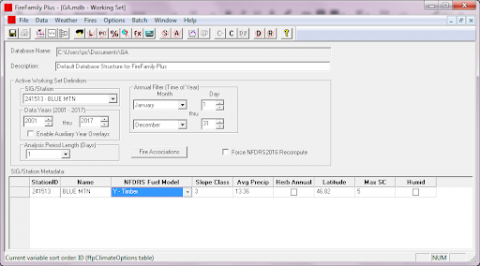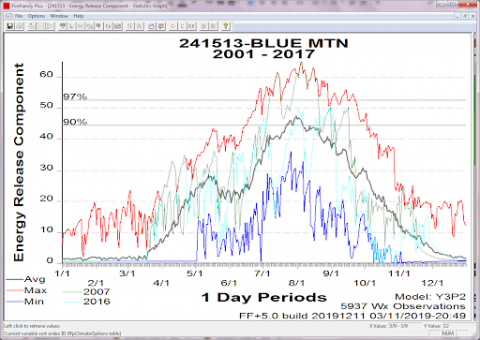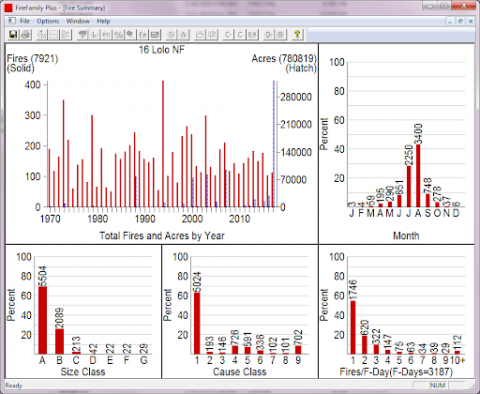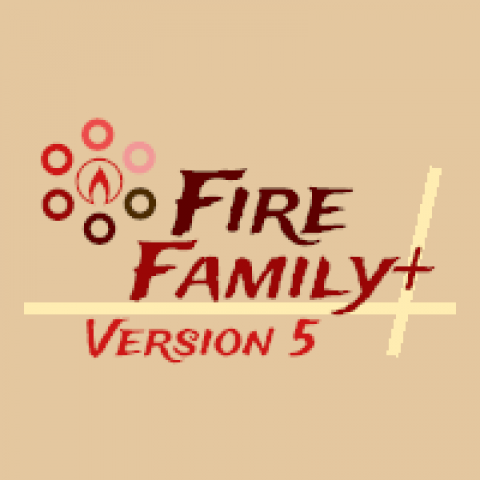FireFamily+ (FF+) is a software package used to calculate fuel moistures and indices from the US National Fire Danger Rating System (NFDRS) using hourly or daily fire weather observations primarily from Remote Automated Weather Stations (RAWS). NFDRS use is mandated for fire preparedness and response decisions by all Federal and most State agencies and is operationally run with USFS FAM Weather Information Management System (WIMS).
FF+ has several subsystems. First, it provides all the necessary model calculations to produce fuel moistures and fire danger indices for the NFDRS 1978, 1988 and the newly added NFDRS2016 and well as the Canadian Forest Fire Danger Rating System and the Fosberg Fire Weather Index. When using appropriate hourly fire weather data, usually provided in an FW13 text format, the system can calculate hourly Nelson dead fuel moistures, daily Growing Season Index-based live fuel moistures and all associated fire danger indices such as the Energy Release Component, Burning Index, Spread Component and Ignition Component as part of the new NFDRS2016. Second, the system includes the ability to compare fire danger indices to agency fire reports and use this information to establish breakpoints for decision making on local units. Finally, FF+ includes a suite of climatological tools to explore and display seasonal variations in fire danger to better assess and communicate conditions as they change throughout a fire season or from year-to-year.
This tool is constantly improved by developers of the US National Fire Danger Rating at the USFS, RMRS, Missoula Fire Sciences Laboratory in collaboration with developers from Altura Solutions.
Uses of FireFamily+ include:
-
FireFamily+ can be used to compute indices and components of the National Fire Danger Rating System (NFDRS), and the Canadian Forest Fire Danger Rating System from weather climatology data.
-
FF+ can summarize weather climatology to produce climatological breakpoints for fire management decision making.
-
Combining the fire occurrence record in the analysis displays the historical relationships between weather conditions and increasing fire occurrence which can be used to set fire business thresholds and track seasonal progression of Fire Danger.
-
Analysis of specific weather information helps in estimating fire potential for an ongoing fire’s continued growth. For example, analyzing the precipitation record can assess the likelihood of an adequate amount of rain occurring by specific points in time to slow or stop fire growth. Examining the wind record can help with determining the most likely direction for long term fire growth.
History: Initiated in 1998, Version 1.0 release (1999) replaced 5 independent, disjointed DOS programs. It resolved pending Y2K issues and provided modern access to both the data and analysis routines. It has significantly improved the effectiveness of national, regional, and local Interagency National Fire Danger Rating System (NFDRS) training courses, which address firefighter safety issues identified in IRMT (A.6). It is the computational and analysis cornerstone for Advanced Fire Danger Rating (at NAFRI) and S-491 (Regional/Local Fire Danger Rating) and provides climate summaries for techniques taught at at S-495, Geospatial Fire Analysis Interpretation & Application to support long-term fire behavior analysis. It generates the Fire Danger Rating Pocket Cards required by the 30-Mile Abatement Plan and supports the Predictive Services functions at all the Geographic Coordination Centers. Updates have been supported by the U.S. Forest Service Fire and Aviation Management (sponsor) and the Rocky Mountain Research Station (developer). FireFamily+ 4.1 is the most recent certified version was approved for installation on U.S. Forest Service and Bureau of Land Management Computers in June 2013 and Version 4.2 was certified in mid-2014. These versions have all been superseded by Version 5.0, which is also approved for installation on USDA and BLM / DOI computers.
Technical Support:
The first level of technical support is provided through your local support channels.
The second level of technical support is provided by the USDA Forest Service Fire and Aviation Interagency Incident Applications (IIA) HelpDesk.
Phone: (866) 224-7677 or (616) 323-1667,
Fax: (616) 323-1665
E-mail: IIA-Helpdesk@usda.gov
Website: https://iia-hd.peckham-enclave.us/
The IIA HelpDesk is available for help with software issues only and cannot answer fire behavior questions.
Bug Reports: If you think you have found a bug within FireFamily+, we would appreciate hearing from you. Please check the Known Bugs below to make sure that this problem has not already been resolved. Then, send a copy of any screenshots and a detailed error message describing the problem and what you were doing when the problem arose. This will help us to recreate the problem and then resolve the issue.



